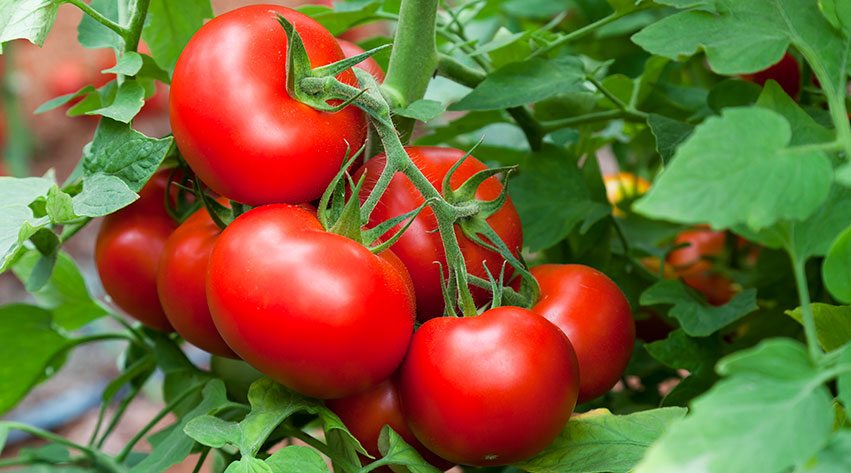- When to sow: February – April
- When to harvest: July – October
- Ready in: 5 months
- Challenge level: Dedication required

How to grow your own tomatoes
There is nothing like the taste of homegrown tomatoes, and they are fairly simple to grow and look after. Tomatoes really like warmth, so it’s best to sow them indoors between February and April. If you’re planning to grow outdoors, plants should be hardened off first, by moving them outside for prolonged periods of time on a gradual basis.
When and where to grow tomatoes
Preparation
It’s best to use soil that hasn’t been used to grow tomatoes before, so either choose an unused area or change the soil before growing tomatoes again. This will help to prevent soil pests and root diseases from becoming a problem. It’s also a good idea to rake a general purpose fertiliser into the soil just before you plant.
How to plant tomatoes
Sprinkle your tomato seed thinly on the surface of good quality seed compost, then cover with about 1.5cm of compost and water lightly with a fine-rose watering can. If you only require a few plants, sow two seeds into each small pot, then remove the smaller plant after germination.
As soon as the tomato seedlings are large enough to handle, pot them on taking care not to touch the stem. Handle plants by the leaves and move them carefully into pots that are 7.5cm. Keep in mind how much tomatoes like the warmth and take care not to expose the plants to frost, cold winds and draughts.
How to grow tomatoes
Whether you’re growing in a greenhouse or outdoors, young plants should be planted on when they are about 15-20cm tall and the flowers on the first truss are beginning to open.
Outside
When the risk of frost has passed in mid- to late May, you can plant tomatoes outside. Leave approximately 45cm between each plant and around 75cm between each row of plants. Be sure to dig in plenty of compost or manure if the weather is still wintery and rake in a general purpose fertiliser just before you start planting – tomatoes are hungry plants!
Try something new
You can also grow tomatoes upside-down to save space. Simply plant a young tomato plant through a hole in a hanging container or bucket, then fill the container with multipurpose compost and suspend the container from a bracket. This will allow the plant to hang down beneath it which is a great space saver.
In a greenhouse
You can grow tomatoes in pots or a grow bag in your greenhouse, but these will require a lot more water and tender, loving care. Similarly to outdoors, plant the plants approximately 45cm apart and leave around 75cm between the rows. Two plants per grow bag is usually ideal.
Caring for tomatoes
As well as being a hungry plant, tomatoes need a lot of water to get the best fruit. For the best results, water little and often. A general liquid feed is recommended until the first truss has formed and then a high potash feed should be alternated every 10-14 days to encourage more flowers and fruit. Keep in mind that tomatoes generally prefer a temperature of 21 – 24°C. Keep the compost moist but be careful to avoid overwatering as this can cause moulds and diseases.
Harvesting tomatoes
As soon as the fruit is ripe and fully coloured, it’s ready to pick (and eat). At the end of each growing season, lift any plants with remaining unripe fruit and lay them on straw under cloches or hang them in a cool shed to ripen. Top tip: you can also pick the green fruit and store in a drawer next to a banana to aid ripening.
Common problems
Tomato blight is one of the most common problems when growing tomatoes. This spreads particularly quickly in wet weather, causing the plant to die and the fruits to decay. Tomato blight can be recognised by brown patches on all part of the plant. This problem happens more often if you’re growing outside but spraying Bordeaux Mixture on the plants in early summer can help.
Irregular watering can lead to a number of fruit problems such as “blossom end rot” which is characterised by a dark patch at the base of the fruit; “blossom drop” where the flower bud falls off; “dry set” where the fruit stops growing at the size of a match head and “fruit splitting”. All of these can be avoided by giving your tomatoes an even amount of water on a regular basis.
Like most plants, green and white fly can be a particular pest on tomatoes and both can spread viruses across your crops. Use an insecticide as soon as any pest is noticed or stick to a natural pest control if you’re creating an organic garden. Some flowers, such as Marigolds, can be planted to attract beneficial insects which will eat the green and white flies.


